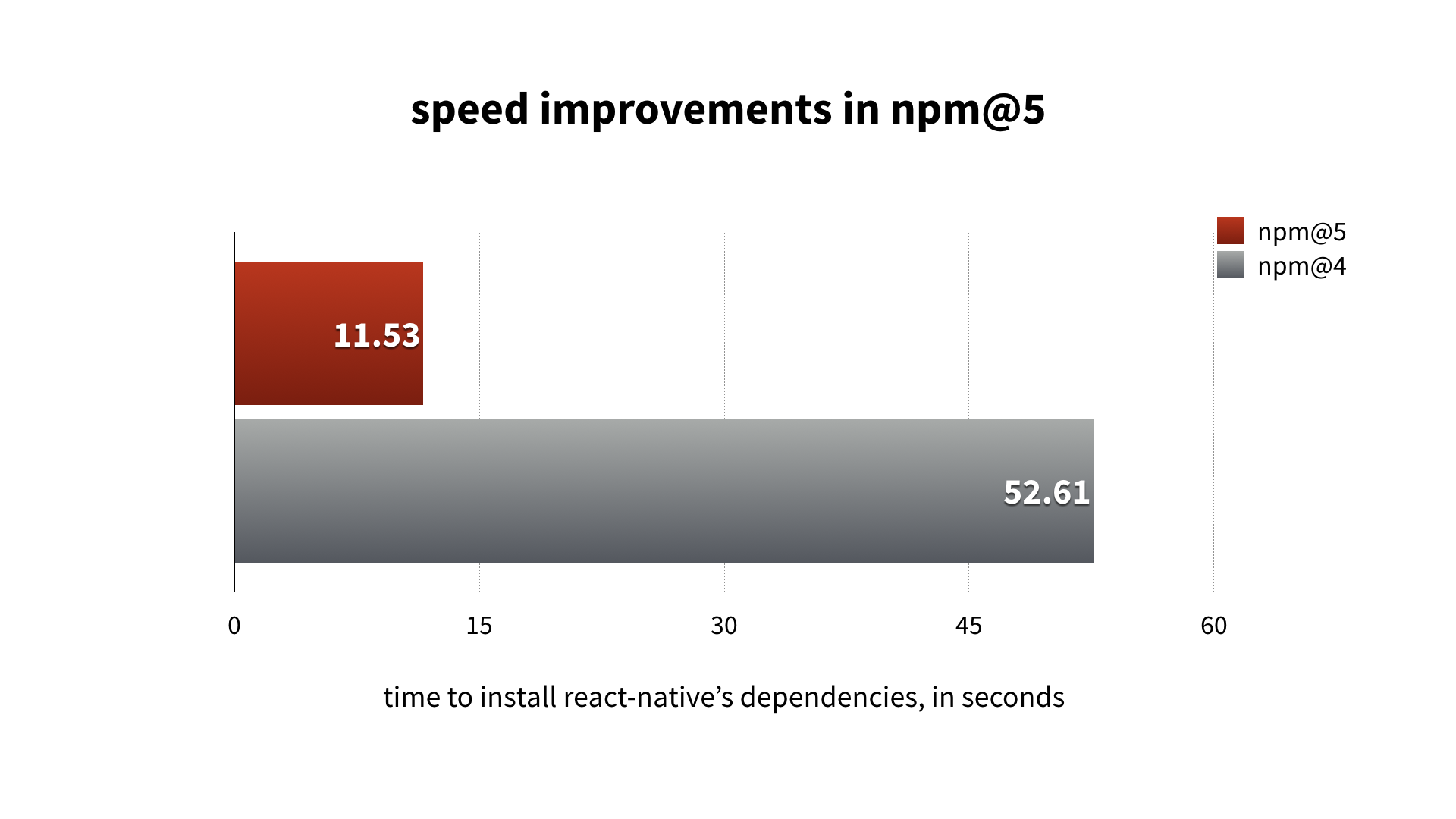The npm blog has been discontinued.
Updates from the npm team are now published on the GitHub Blog and the GitHub Changelog.
npm@5 is now `npm@latest`

It’s here!
Starting today, if you type `npm install npm@latest -g`, you’ll be updated to npm version 5. In addition, npm@5 is bundled in all new installations of Node.js 8, which has replaced Node.js 7 in the Node Project’s current release line.
Over the last year and a half, we’ve been working to address a huge number of pain points, some of which had existed since the registry was created. Today’s release is the biggest ever improvement to npm’s speed, consistency, and user experience.
The definitive list of what’s new and what’s changed is in our release notes,
but here are some highlights:
It’s fast
We’ve reworked package metadata, package download, and package caching, and this has sped things up significantly. In general, expect performance improvements of 20–100%; we’ve also seen some installations and version bumps that run 5x faster.

(Installing the npm website on our own dev environments went from 99 seconds using npm@4 to 27 seconds with npm@5. Now we spend less time jousting.)
Since npm was originally designed, developers have changed how they use npm. Not only is the npm ecosystem exponentially larger, but the number of dependencies in the average npm package has increased 250% since 2014. More devs now install useful tools like Babel, Webpack, and Tap locally, instead of globally. It’s a best practice, but it means that `npm install` does much more work.
Given the size of our community, any speed bump adds up to massive savings for millions of users, not to mention all of our Orgs and npm Enterprise customers. Making npm@5 fast was an obvious goal with awesome rewards.
It’s consistent
Default lockfiles
Shrinkwrap has been a part of npm for a long time, but npm@5 makes lockfiles the default, so all npm installs are now reproducible. The files you get when you install a given version of a package will be the same, every time you install it.
We’ve found countless common and time consuming problems can be tied to the “drift” that occurs when different developer environments utilize different package versions. With default lockfiles, this is no longer a problem. You won’t lose time trying to figure out a bug only to learn that it came from people running different versions of a library.
SHA-512 hashes
npm@5 adds support for any tarball hash function supported by Node.js, and it publishes with SHA-512 hashes. By checking all downloaded packages, you’re protected against data corruption and malicious attacks, and you can trust that the code you download from the registry is consistent and safe.
Self-healing cache
Our new caching is wicked fast, but it’s also more resilient. Multiple npm processes won’t corrupt a shared cache, and npm@5 will check data on both insertion and extraction to prevent installing corrupted data. If a cache entry fails an integrity check, npm@5 will automatically remove it and re-fetch.
It’s easier to use
With your feedback, we’ve improved the user experience with optimizations throughout npm@5. A big part of this is more informative and helpful output. The best example of this is that npm no longer shows you the entire tree on package install; instead, you’ll see a summary report of what was installed. We made this change because of the larger number of dependencies in the average package. A file-by-file readout turned out to be pretty unwieldy beyond a certain quantity.
It needs you
npm@5 is a huge step forward for both npm and our awesome community, and today’s release is just the beginning. A series of improvements in the pipeline will make using npm as frictionless as possible and faster than ever before.
But: npm exists because of its users, and our goal remains being open and flexible to help people build amazing things, so we depend on your feedback.
What works for you? What should we improve next? How much faster are your installs? Let us know. Don’t hesitate to find us on Twitter, and, if you run into any trouble, be sure to drop us a note.